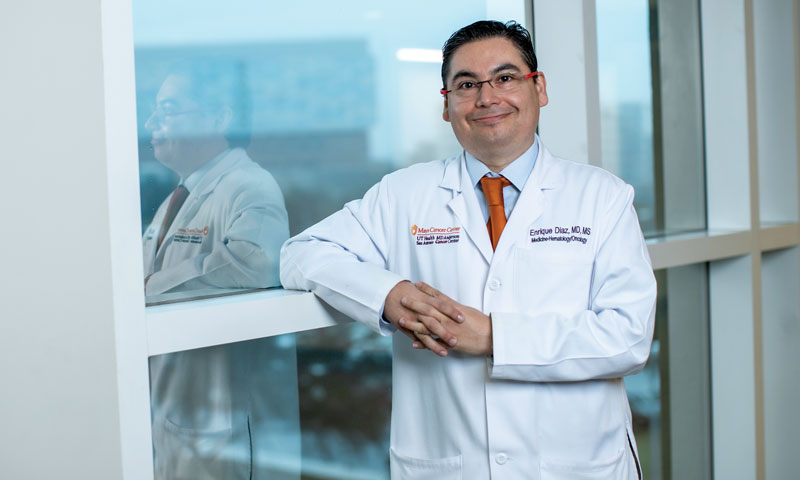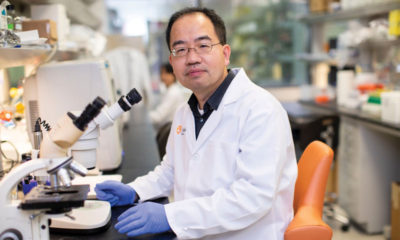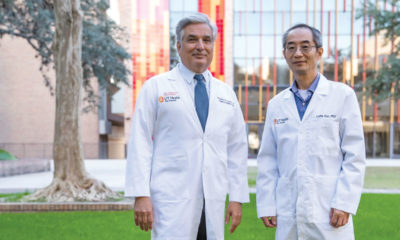Research focused on improving lymphoma treatments for Hispanics

Mays Cancer Center Annual Report
It’s widely believed that Caucasians get better results from cancer treatments than Hispanics. But a study of Hodgkin’s lymphoma patients conducted by Enrique Diaz, M.D., director of the Lymphoma Program at the Mays Cancer Center, dispels that notion.

Lymphomas are cancers that start in white blood cells called lymphocytes, and the two main types are Hodgkin’s lymphoma and non-Hodgkin’s lymphoma.
Of the Hodgkin’s lymphoma patients treated at the Mays Cancer Center, “Hispanics tended to do about the same if not better than non-Hispanics with no statistically significant difference in outcome,” Dr. Diaz says.
His research analyzed a total of 616 patients, ultimately identifying 116 Hodgkin’s lymphoma patients for inclusion. The study looked at the group over 10 years, beginning in 2008 and concluding in 2018. Of the patients, 63 percent were Hispanic, 36 percent were non-Hispanic, and 1 percent had an unspecified ethnicity. The average age was 37.4 years, and the largest percentage were diagnosed Stage II, although all cancer stages were represented. Men made up 58 percent of the group studied.
Dr. Diaz says he was shocked by the results since, historically, Caucasians are seen to have a more positive outcome after a lymphoma cancer diagnosis than Hispanics, African Americans and Pacific Islanders. The survey is the largest study of Hodgkin’s lymphoma patients from a single academic institution that primarily serves Hispanics.
His interest in conducting the study was spurred by the lack of information comparing the outcomes of Hispanic patients with lymphoma with those of Caucasians, African Americans and other ethnicities with lymphoma, he says.
The study also looked at survival outcome rates between lymphoma patients who have private insurance or Medicare versus those who are uninsured, on Medicaid or use a hospital payment plan available at the Mays Cancer Center.
With 477 patients in the overall study, 47 percent had commercial insurance, 24 percent had Medicare, 18 percent were approved for indigent care coverage, 4 percent had Medicaid, and 7 percent were unfunded.
“We were under the assumption that those patients lacking insurance would not do as well as those with a health policy in place,” Dr. Diaz says.
Again, to his surprise, the study found there was no significant vitality difference between patients with private insurance or Medicare versus those who were unfunded or had Medicaid or indigent care coverage.
“Even with the challenges of a lack of health insurance, those patients did about the same (as insured patients),” he says.
Dr. Diaz can’t be sure of the reason, theorizing that it may be the quality of care that the Mays Cancer Center provides all its cancer patients, the fact that the center has a hospital payment plan which helps the uninsured, or possible differences in biology.
“It’s quite shocking,” he says of the findings that demonstrated that regardless of the type of lymphoma there was no difference in longevity whether or not patients had insurance.
The study also looked at the effect co-morbidities have on lymphoma patients at the center, again comparing Hispanic and non-Hispanic populations. The thinking was that the simultaneous presence of more than one disease would negatively impact treatment decisions and outcomes.
The study identified 477 patients with both Hodgkin’s and non-Hodgkin’s lymphoma. Males made up 51 percent of the population; 55 percent were Hispanic, 43 percent were non-Hispanic, and 2 percent were not specified.
Of the co-morbidities — hypertension, diabetes, chronic kidney disease, coronary artery disease and congestive heart failure — looked at in these 477 patients, the combination of congestive heart failure and coronary artery disease had the most negative impact on patient outcome. The study showed that in the prominently Hispanic population the center serves, co-morbidities increased the risk of a poor cancer outcome. There was a higher risk for negative outcomes in the non-Hispanic population than in the Hispanic group, though further studies are needed.
Hispanics have historically been underrepresented in studies, says Dr. Diaz, who presented his findings at the annual meeting of the American Society of Hematology in late 2019 in Orlando, Florida.
Dr. Diaz, who completed his medical training with honors at the Pontificia Universidad Javeriana in Colombia and his internal medicine residency at New York University, worked on the study for two years. His research focuses on both improving cancer outcomes in his lymphoma patients and on disparities in health care.
Currently serving as Ambassador for the American Society of Hematology, Dr. Diaz plans to do future studies with a larger population sample over a longer time frame, possibly 20 years.
Dr. Diaz said the specialty has particular appeal to him because of the often-positive outcomes in lymphoma patients.
“I get to deliver good news,” he says. “I like that.”




